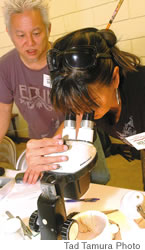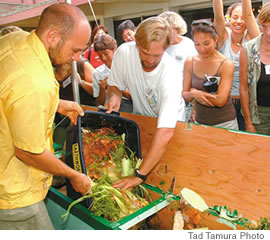Fun With Worms
As MidWeek learns at the first annual Hawaii Worm Conference, they’re creepy-crawly but hard working

Holly Pontes gets an
up-close look at a worm
under a microscope
during a workshop with
Dr. Sam James. Dennis
Imoto looks on
Worms are “really the greatest thing since sliced bread,” boasts Honolulu resident Mindy Jaffe. Jaffe should know, too, because she owns the Oahu-based Waikiki Worm Company, and her brain is filled with a plethora of knowledge on vermicomposting, or recycling with worms. In fact, MidWeek caught up with Jaffe on on a recent Saturday at the first annual Hawaii Worm Conference, a day dedicated to “spreading the worm” on vermicomposting.
MidWeek wore its environmental hat to the event, held at Christ Church Uniting in Kailua, to learn the inside scoop on the magic of how worms can reduce and recycle our garbage.
“We’ve really gone out of our way. Everyone here is looking for fun ways to reduce waste.
This is not your ordinary event,” explains Jaffe.
And ordinary, it was not. The former member of the state environmental protection committee excitedly points out the reusable squeeze bottles, tote bags made from recycled plastic (they really feel like fabric!) and mini compost bins for sale. She adds that come lunch time, guests will use chopsticks to eat with, which they can take home and reuse, and recycled paper cups and plates, sticking to the day’s “zero waste” policy.
“Everything created is going to our worms,” says Jaffe, a former state legislator.
After chowing down on lunch, Jaffe instructs guests to put all their waste, including their recycled paper plates and cups, into two large bins. She then opens the lid on a large, narrow wooden bin, inside of which 10,000 worms (or 10 pounds - there’s about 1,000 worms per pound) await their own mid-day meal. Bryan Silver, designer of the wooden worm bin and science teacher at Kalani High School, is assisted by a friend in pouring the waste in with the worms.

The worm conference crowd gathers round while Gary
Seals and Bryan Silver dump waste from lunch and
breakfast into the composting bin.
“In about a week, this will all be gone,” Jaffe tells her audience.
Thus begins the vermicom-posting process. In a nutshell, worms wait for organic matter to break down, or “go gooey,” as Jaffe says. “And use a little muscle to suck it in.” At this point she adds, the waste isn’t really food scraps or pieces of paper anymore, it’s actually turned into a good bacteria.
“Worms are actually eating bacteria that is breaking the food down.”
The magic of worms, she continues, is that their insides are like a “paradise for bacteria.” Worms derive nutrients from the bacteria, then produce waste or vermicast, which is used in a variety of ways, including fertilizer, or turned into an organic spray for plants.
“Huge globs of bacteria is what vermicast is,” Jaffe says. “This is what they (worms) do. This is what composting worms are on the planet for. It’s amazing stuff.”
Elsewhere at the conference the guests, most of whom are teachers, make their way to several presentations by experts in the vermicomposting/worm field. Downstairs in the church’s large auditorium, Scott Subler, president and co-founder of Environmental Credit Corp. and recognized expert in vermiculture, talks to eager listeners about “Understanding Teas made from Earthworm Castings and Compost.” (The tea in this case is for plants, not humans. Whew.)
Outside, across from the auditorium, Jaffe leads a small group in a harvest session, for harvesting mature mini-bins of worms. Upstairs, taxonomy expert and earthworm ecology researcher Dr. Sam James discusses the exciting world of “Worm ID and the Hawaii Biological Survey.”
Down the hall, Kelly Slocum shows her workshop students all about “Integrating the Worm Bin into the Learning Environment.” Slocum is a vermiculture specialist and a recognized authority on alternative waste management systems.
Outside, the wooden bin used during the lunch was moved to the Honolulu restaurant Town, where it will remain and be used by the eatery to recycle waste. To keep the cycle going, Town is now using the vermicast as fertilizer for its on-site herb garden.
Jaffe and friends opened the bin four days after the workshop to see if the worms were done eating and discovered they’d already gone through most of the waste.
This is the first time Jaffe has “tried this on a commercial scale,” and she is hopeful it will catch on and become a trend among many of the island’s smaller businesses. Ideally, Jaffe would like to specifically target businesses that by themselves don’t produce enough waste “for the big waste company to take,” but when their waste is combined with that of a lot of other smaller businesses, for example, it can all be put together for a large vermicomposting bin. One of her goals is to “find some kind of a grant so that people who set up a worm bin can get some kind of a rebate,” she explains, because the biggest expense of this sort of venture
Page 1 of 2 pages for this story 1 2 >
E-mail this story | Print this page | Comments (0) | Archive | RSS
Most Recent Comment(s):








